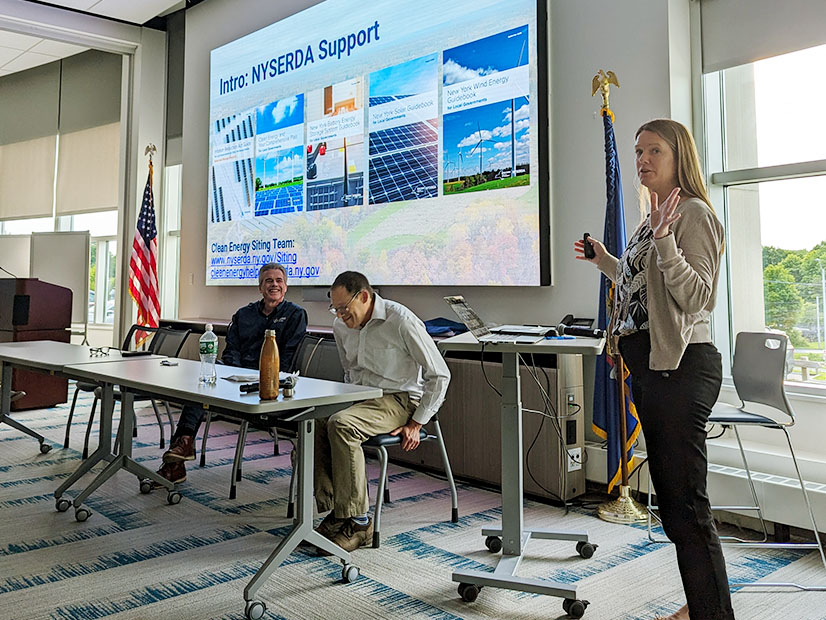BOSTON — Energy experts and officials stressed the importance of proactive transmission planning, interconnection reform and increased demand-side flexibility at Raab Associates’ New England Electricity Restructuring Roundtable on Sept. 19.
Speakers at the event reflected on the challenges the One Big Beautiful Bill Act (OBBBA) and the Trump administration’s executive actions have created for clean energy development in New England, but they generally expressed optimism around the region’s ability to withstand the federal headwinds.
“There will be pain, there will be companies that close, there will be less deployment as a result of the changes at the federal level,” said Nathan Phelps, managing director of regulatory advocacy at Vote Solar.
However, “solar will not fall off a cliff” because “the price of solar has come down a lot, and it continues to be an attractive investment,” Phelps said.
The OBBBA dramatically expedites the expiration of federal tax credits for wind and solar developers, and new projects must either begin construction by July 5, 2026, or come online by Dec. 31, 2027, to qualify for the full tax credits established by the Inflation Reduction Act. (See U.S. Clean Energy Sector Faces Cuts and Limitations.)
In New England, the looming tax credit phaseout has caused a mad dash for solar developers to try to lock in credits for later-stage projects, which may boost development in the short-term. Meanwhile, projects unable to begin construction in time for the deadlines likely will face increased risks of cancellation or major delay.
While the longer-term effects of the shift in federal policy are less clear, the Trump administration’s antagonism toward offshore wind in particular threatens to undermine the buildout of a strong regional supply chain and workforce, which could have effects extending well beyond Trump’s second term. (See Tax Credit Phaseout Threatens Projects, Jobs in New England.)
In the wake of the Trump administration’s stop-work order on Revolution Wind, “it’s really hard to have any confidence around what we can expect from the federal level,” Phelps said.
Alicia Barton, CEO of Vineyard Offshore, emphasized the importance of offshore wind for meeting load growth in the coming decades.
“I don’t think we have a choice — the region needs offshore wind,” Barton said.
She declined to comment on the halt on Revolution Wind, which is being developed by Ørsted, but said Vineyard Wind, which is being developed by Vineyard Offshore and Avangrid, still aims to achieve commercial operations by the end of the year.
“We are still constructing, we are still moving forward,” Barton said, adding that Vineyard Wind has created 3,400 jobs, including 1,400 union jobs.
On Sept. 22, after the roundtable, a U.S. District Court judge issued an injunction allowing construction to resume on Revolution Wind. (See Judge Lifts BOEM’s Stop-work Order on Revolution Wind.)
Interconnection Reform
Speakers also discussed how reducing the soft costs of renewable development — including costs and delays associated with siting, permitting and interconnection — could help mitigate the effects of federal policy changes.
On interconnection, “the most important near-term thing is implementation of Order 2023,” said Caitlin Marquis, managing director at Advanced Energy United.
FERC Order 2023 requires transmission operators to adopt first-ready, first-served cluster processes for interconnection. ISO-NE’s first cluster study under the new rules will begin in October.
“ISO-NE deserves a lot of credit for holding a robust stakeholder process to implement Order 2023,” Marquis said, while emphasizing that interconnection reform must go further than Order 2023 compliance to better integrate interconnection planning into the transmission planning process.
Marquis also highlighted the potential benefits of processes that allow new resources to share interconnection service with existing ones. She noted that ISO-NE has a surplus interconnection service option in its tariff but that stakeholders seek more flexibility.
At the state level, the administration of Massachusetts Gov. Maura Healey (D) has “made good strides” toward a more proactive approach for resource interconnection but is seeking to “consolidate some of the siloed processes into a more comprehensive planning process,” said Michael Judge, undersecretary at the Massachusetts Executive Office of Energy and Environmental Affairs.
He said state officials hope to replace the Capital Investment Project process, a provisional program intended to enable fixed distribution interconnection costs, with a proactive interconnection planning process incorporated into the utilities’ five-year electric-sector modernization plans.
Rob Gramlich, president of Grid Strategies, praised increased transmission planning initiatives taking place across New England. He noted that ISO-NE rated poorly in a pre-Order 2023 interconnection “report card” but that the Order 2023 compliance changes should help address some of the issues. (See Transmission Report Card Grades MISO ‘B,’ Southeast ‘F’.)
“Transmission planning is the key solution here,” he said.
Demand Response
Multiple speakers stressed the need to focus on demand response and flexibility.
For policymakers looking to decarbonize at the lowest possible cost, “one resource is way more important than all the others, and that’s the demand side,” said Paul Hibbard, principal at the Analysis Group and former chair of the Massachusetts Department of Public Utilities.
Hibbard said unlocking the full potential of demand response will require “fundamental changes” to rate design and programmatic spending.
“The technological hurdle to this is not a big one, it’s really getting the price incentives up and running and the infrastructure in place,” he said, adding that states must begin this work as soon as possible given the “painfully slow” pace of ratemaking.
Massachusetts’ electric utilities aim to finish deploying advanced metering infrastructure across their service territories by the end of the decade, which should enable increased retail price incentives to reduce demand during peak periods.
“Electrification depends on it, affordability depends on it, and ultimately the commonwealth’s decarbonization policy depends on it,” Hibbard said.



